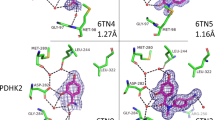Abstract
Bioisosteres are functional groups or atoms that are structurally different but that can form similar intermolecular interactions. Potential bioisosteres were identified here from analysing the X-ray crystallographic structures for sets of different ligands complexed with a fixed protein. The protein was used to align the ligands with each other, and then pairs of ligands compared to identify substructural features with high volume overlap that occurred in approximately the same region of geometric space. The resulting pairs of substructural features can suggest potential bioisosteric replacements for use in lead-optimisation studies. Experiments with 12 sets of ligand–protein complexes from the Protein Data Bank demonstrate the effectiveness of the procedure.










Similar content being viewed by others
References
Burger A (1991) Prog Drug Res 37:287
Patani G, LaVoie E (1996) Chem Rev 96:3147
Olesen PH (2001) Curr Opin Drug Discov Dev 4:471
Mederski W, Osswald M, Dorsch D, Anzali S, Christadler M, Schmitges C, Wilm C (1998) Bioorg Med Chem Lett 8:17
Uddin M, Praveen Rao P, Knaus E (2003) Bioorg Med Chem 11:5273
Showell G, Mills J (2003) Drug Discov Today 8:551
Schneider G, Neidhart W, Giller T, Schmid G (1999) Angew Chem Int 38:2894
Bohl M, Dunbar JB, Gifford E, Heritage T, Wild DJ, Willett P, Wilton DJ (2002) Quant Struct Act Relat 21:590
Böhm H-J, Flohr A, Stahl M (2004) Drug Discov Today: Technol 1:217
Ujváry I (1997) Pest Sci 51:92
The BIOSTER database is available from Accelrys Inc. at http://www.accelrys.com/products/chem_databases/databases/bioster.html
Wagener M, Lommerse JPM (2006) J Chem Inf Model 46:677
Sheridan R (2002) J Chem Inf Comp Sci 42:103
Ertl P (1998) J Mol Graph Model 16:11
Holliday JD, Jelfs SP, Willett P, Gedeck P (2003) J Chem Inf Comp Sci 43:406
Zhu Q, Yao J, Yuan S, Li F, Chen H, Cai W, Liao Q (2005) J Chem Inf Model 45:1214
Hirons L, Holliday JD, Jelfs SP, Willett P, Gedeck P (2005) QSAR Combin Sci 24:611
Bruno IJ, Cole J, Lommerse R, Rowland R, Taylor R, Verdonk M (1997) J Comp Aid Mol Des 11:425
The IsoStar database is available from the Cambridge Crystallographic Data Centre at http://www.ccdc.cam.ac.uk/products/knowledge_bases/isostar/
Watson P, Willett P, Gillet VJ, Verdonk M (2001) J Comp Aid Mol Des 15:835
Chemical Computing Group is at http://www.chemcomp.com
Berman HM, Battistuz T, Bhat TN, Blum WF, Bourne PE, Burkhardt K, Feng Z, Gilliland GL, Iype L, Jain S, Fagan P, Marvin J, Padilla D, Ravichandran V, Schneider B, Thanki N, Weissig H, Westbrook JD, Zardecki C (2002) Acta Crystallogr D58:899
Kearsley SK, Smith GM (1990) Tetrahed Comput Methodol 3:615
Kennewell L (2004) Identifying bioisosteric fragments from databases of protein-ligand complex X-ray crystallographic structures. MSc dissertation, University of Sheffield
Author information
Authors and Affiliations
Corresponding author
Rights and permissions
About this article
Cite this article
Kennewell, E.A., Willett, P., Ducrot, P. et al. Identification of target-specific bioisosteric fragments from ligand–protein crystallographic data. J Comput Aided Mol Des 20, 385–394 (2006). https://doi.org/10.1007/s10822-006-9072-0
Received:
Accepted:
Published:
Issue Date:
DOI: https://doi.org/10.1007/s10822-006-9072-0




